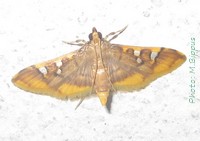Spilomelinae
[2][3] In resting position, the moths exhibit a characteristic triangular shape, with the wings usually folded over the abdomen, the forewings covering the hindwings.
All Spilomelinae moths have well-developed compound eyes, antennae and mouthparts, although in the genera Niphopyralis and Siga the proboscis is lost.
[4] Synapomorphic characters of the subfamily comprise minute or obsolete maxillary palpi, ventrally projecting fornix tympani, and the female genitalia's ductus bursae with a weak sclerotization or a granulose texture.
[19][20] However, a recent phylogenetic study by Mally et al. (2019), based on molecular genetic and morphological data, found the subfamily to be monophyletic.
[4] The tribes Agroterini, Margaroniini, Spilomelini, Herpetogrammatini, Hymeniini, Asciodini, Trichaeini, Steniini and Nomophilini form the monophylum of "euspilomelines" (Greek eu- for "good" or "true"), all sharing a common ancestor.













